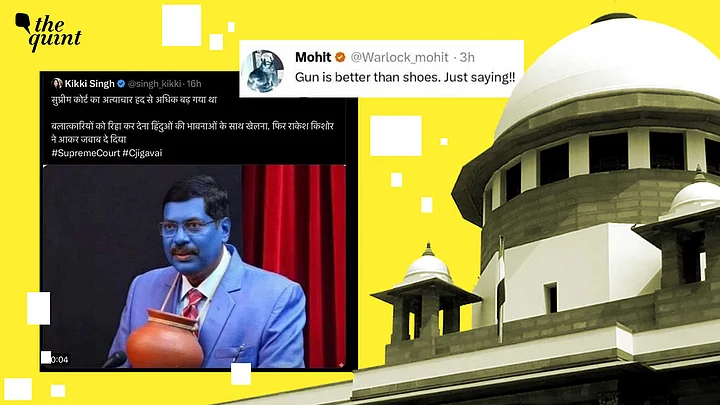It was UPSC topper Tina Dabi then, and now it is Chief Justice BR Gavai. What does it mean to carry the label of "SC" or "Dalit" and find oneself at the epicenter of a “national debate”?
Dr BR Ambedkar experienced it throughout his public life. Being a leader of the 'untouchables', subjected to vicious caricatures in the press, death threats during the Poona Pact, and fierce opposition from conservative Hindu factions over the Hindu Code Bill. Former Chief Minister of Uttar Pradesh, Mayawati, endured years of casteist ridicule, especially on TV and print media, with even stand-up comedians using her as the theme of crude jokes.
The most prominent among Dalits have never been spared the deeply casteist hostility of India’s public sphere. Yet, the current context reveals something more alarming.
Virtual Casteism
The public discourse in India has expanded to include a virulent alliance of right-wing digital content creators, godmen, "X" (formerly Twitter) users, Brahminical clergy, and complicit TV media. This ecosystem operates as a spontaneous coalition, mobilising around any topic or individual that they perceive as a threat to the cultural and social dominance of upper-caste Hindus.
Their ideology, cloaked under the term “Sanatani,” is intolerant of both Dalit excellence and Ambedkarite ideology as existential threats. In this worldview, any Dalit who achieves prominence or articulates Ambedkarite ideals in opposition to them is cast as a disruptor.
Their mere presence at the top, and their willingness to voice dissent, becomes justification for targeted campaigns of harassment, abuse, and even incitement to violence as seen recently in the case of Justice BR Gavai.
For weeks, Justice Gavai was subjected to coordinated trolling across digital platforms. A digital mob egged on by popular right-wing influencers on X and Instagram vilified him in explicit and casteist terms. Despite occupying one of the most powerful positions in the judiciary, he was not shielded from public humiliation.
While a few top BJP leaders issued vague expressions of concern, careful not to appear anti-Dalit, the same government has allowed the rise and sustenance of a toxic digital ecosystem.
One section of their audience believes that the BJP is already advancing their interests, while another demands aggressive representation in the digital sphere voices that will speak “their truth,” a version of history and culture they feel has been silenced by liberal, secular institutions. These audiences actively promote content creators who indulge in polemics, misinformation, and anti Dalit-Bahujan and anti Muslim content, often reframing the hate as resistance to "anti-Sanatani" liberalism.
It is this carefully nurtured ecosystem that orchestrates “national debates,” weaponising social media to dehumanise individuals like Justice Gavai.
Not Your Everyday RW Bigotry
What happened in his case cannot be dismissed as just another instance of right-wing bigotry. It carries a deeper, more disturbing significance. It underscores the entrenched caste contempt still prevalent in India's digital and public life.
When a Dalit does break through to the highest echelons as in the case of the Chief Justice of India, they are almost immediately marked not just as individuals, but as symbols.
History remembers them as “the first” or “the second,” Dalit, while society continues to remind them of their place through humiliation, repugnance, and exclusion.
This hostility is not limited to the powerless ordinary Dalits. Even Dalits in the highest offices are not immune from being isolated and harassed.
It was Tina Dabi after her UPSC success, (Dabi was the first Dalit woman to top the exams in 2015) and now CJI Gavai. If a Dalit Chief Justice can be publicly humiliated, a shoe thrown at him by a lawyer—Rakesh Kishore, who later justifies it as a defense of Sanatana Dharma and is deified on social media—and then attacked by right-wing media with casteist undertones, the signal it sends is chilling.
Despite loud public tributes to Dr Ambedkar and performative gestures of Dalit inclusion by political parties, such incidents lay bare the fragility of Dalit dignity in India’s upper echelons of power.
These trends don’t just intimidate individuals they work to dissuade a whole generation of Dalits from speaking their minds, participating in high public discourse, in exercising their duties in top public institutions or aspiring to positions of leadership for fear of becoming targets.
How to Stop Online Caste Hate
Meanwhile, emboldened by inaction, this right-wing casteist ecosystem will continue expanding the boundaries of "hurt sentiments," using them as pretext for spreading hate. In order to curb such actions, the following are imminent steps worth considering:
● Stringent implementation of the SC/ST (Prevention of Atrocities) Act is crucial particularly in digital contexts where caste abuse flourishes unchecked.
● Robust content regulation policies must be enacted to hold social media platforms accountable for amplifying casteist hate.
● Mainstream media and influential journalists who legitimise or normalise such abuse should face regulatory scrutiny.
● Tech companies must be made answerable to Indian anti-discrimination laws and should be required to take down caste-based hate content with urgency
(Sumit Samos hails from South Odisha and has recently completed MSc in Modern South Asian Studies from the University of Oxford. He is a musician, researcher, and anti-caste activist.This is an opinion piece. All views expressed are the author’s own. The Quint neither endorses nor is responsible for them.)
